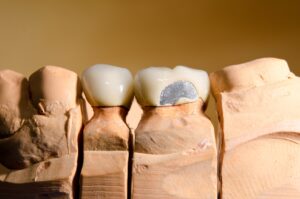Cracked Teeth Treatment
 Cracked teeth have many types of symptoms, including pain while chewing, sensitivity to hot and cold, or even the release of biting pressure. It is also common for pain to be inconsistent and not constant, making it harder to diagnose the cause of discomfort.
Cracked teeth have many types of symptoms, including pain while chewing, sensitivity to hot and cold, or even the release of biting pressure. It is also common for pain to be inconsistent and not constant, making it harder to diagnose the cause of discomfort.
Chewing causes movement of the cracked pieces of your
Types of Cracks
Craze lines – These are tiny cracks that only affect the outer enamel of the tooth. These cracks are more common in adults. These types of cracks are superficial and are usually of no concern.
Fractured Cusp – When a cusp becomes weakened, a fracture may result. The cusp may break off or be removed by a dentist. A fractured cusp rarely damages the pulp, so a root canal is not necessary.
Your dentist will usually restore the tooth with a full crown.
Cracked Tooth – This type of crack extends from the chewing surface of the tooth and vertically migrates towards the root. In some cases, the crack may extend below the gum line. It is possible for the crack to extend further into the root. Damage to the pulp is a commonplace. In this case, root canal treatment is usually necessary. A cracked tooth that is not treated will worsen, resulting in the loss of the tooth. Therefore, early detection is essential.
Split Tooth – A split tooth is usually the result of an untreated cracked tooth. It can be identified by a crack with distinct segments. This type of tooth can never be saved intact. Yet, the position and extent of the problem will dictate whether any portion of the tooth can be saved.
Vertical Root Fracture – A vertical root fracture begins at the root and extends towards the chewing surface of the tooth. Unfortunately, they show minimal symptoms and may go unnoticed. Treatment involves endodontic surgery if a portion of the tooth can be saved by removal of the fractured root.
